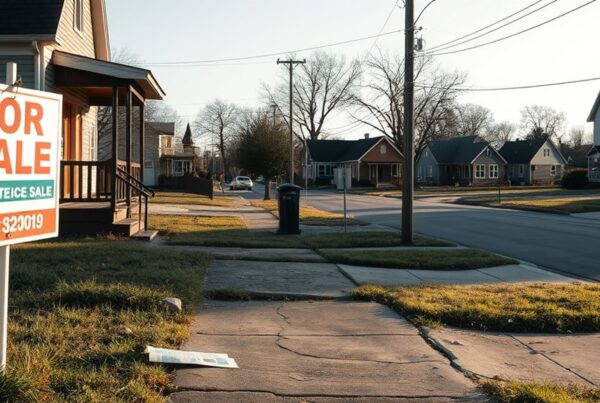If you’re looking for resilient housing markets, focus on states like Oklahoma, Iowa, and Alaska, which have a 0% chance of significant price drops since 2000 due to strong employment and economic stability. Metros like Oklahoma City and Buffalo-Cheektowaga also show consistent price strength, with median home prices around $220,000 to $244,000. Affordability and low debt-to-income ratios further boost resilience in areas like El Paso and Cleveland. Understanding these trends can guide you toward safer, long-term investments.
Key Takeaways
- Oklahoma City, OK, and Buffalo-Cheektowaga, NY show 0% chance of price drops since 2000, indicating high resilience.
- Austin, TX, and Kansas City, MO have strong Housing Market Index scores, reflecting robust demand and stability.
- Affordable markets like El Paso, TX, and Cleveland, OH sustain buyer interest with low price volatility.
- States such as Oklahoma, Iowa, and Alaska consistently avoid significant price declines, offering stable investment opportunities.
- Job growth and low debt-to-income ratios in cities like Philadelphia, PA, enhance housing market resilience.
Stable State Housing Markets
While housing markets across the U.S. have shown varying degrees of volatility, certain states have consistently maintained stability, offering a safer bet for buyers seeking long-term resilience. Oklahoma, Iowa, and Alaska stand out as prime examples of stable state housing markets, with a 0% chance of experiencing a greater-than-5% price drop since 2000. The economic indicators in these states, such as employment rates, contribute significantly to their housing market stability. In contrast, states like Nevada and Georgia face over a 50% probability of price declines, highlighting their susceptibility to fluctuations. This analysis, rooted in historical price drop probabilities, underscores the importance of investing in resilient markets. Housing prices in these stable states have demonstrated remarkable consistency, making them attractive for long-term investment. By focusing on locations with proven resilience, you can mitigate risks associated with market volatility. When evaluating options, prioritize states with a track record of maintaining steady housing prices to guarantee your investment remains secure even during economic downturns.
Large Metros With Stable Housing Markets
Large metros with stable housing markets provide investors and buyers with reliable options in a fluctuating economic landscape. Cities like Oklahoma City, OK, and Buffalo-Cheektowaga, NY, stand out with a 0% chance of a price drop since 2000, offering median home prices of $222,360 and $244,001, respectively. San Antonio-New Braunfels, TX, maintains resilience with an 11% probability of a price drop and a median home price of $340,353. Similarly, Austin-Round Rock-Georgetown, TX, though slightly riskier at a 10.3% chance of a price drop, demonstrates stability with a median price of $549,232. Tulsa, OK, further highlights affordability and market steadiness with a 15% chance of a price drop and a median price of $217,564. Understanding demographic trends in these regions can help investors align their rental strategies with tenant preferences. These metros, analyzed through Zillow’s Home Value Index, reflect consistent performance, making them dependable choices for long-term investments in volatile housing environments.
Top 5 Most Stable Large Metros

When evaluating housing market stability, Oklahoma City, OK, and Buffalo-Cheektowaga, NY, emerge as the top performers with a 0.0% chance of price drops since 2000 and median home prices of $222,360 and $244,001, respectively. These stable metropolitan areas highlight the importance of affordability and resilience in housing markets.
Here’s a breakdown of the top five most stable large metros:
- Oklahoma City, OK: 0.0% chance of price drop; median price: $222,360.
- Buffalo-Cheektowaga, NY: 0.0% chance of price drop; median price: $244,001.
- San Antonio-New Braunfels, TX: 11.0% chance of price drop; median price: $340,353.
- Austin-Round Rock-Georgetown, TX: 10.3% chance of price drop; median price: $549,232.
- Tulsa, OK: 15.0% chance of price drop; median price: $217,564.
These markets demonstrate lower volatility, making them ideal for buyers prioritizing long-term stability and affordable housing. Their consistent performance underscores their resilience in both economic growth and housing demand.
Key Market Trends for Resilient Housing
Resilient housing markets are characterized by their ability to withstand economic shifts, maintaining stability in price trends and demand. These markets often feature affordable housing options, which reduce price volatility and attract steady demand from buyers and investors. Cities like Akron, OH, and Philadelphia, PA, exemplify resilience due to their lower debt-to-income ratios and consistent performance. Markets such as El Paso, TX, and Cleveland, OH, leverage affordable housing to sustain buyer interest and investment activity. Regions like Kansas City, MO, and Buffalo, NY, historically demonstrate stability, with a lower likelihood of significant price drops. Even in areas with recent fluctuations, like Austin, TX, strong job growth and economic fundamentals bolster resilience, as reflected in a Housing Market Index score of 72.8. Florida’s booming real estate market, with home values surging nearly 69% over the past five years, highlights its resilience and long-term investment potential. Overall, resilient housing markets prioritize affordability, minimize price volatility, and offer long-term investment potential, ensuring their enduring appeal.
Hottest Markets With Strong Resilience

Austin’s market stability shines with an HMI score of 72.8, signaling robust demand and resilience even during economic shifts. Kansas City mirrors this strength, supported by demand for single-family rentals and a balanced housing environment. Philadelphia’s job growth and affordability contribute to its housing resilience, making it a standout in uncertain markets. New York City’s real estate market offers strong rental demand with a 97.1% occupancy rate, reinforcing its position as a resilient investment hub.
Austin’s Market Stability
Even with a 5.4% year-over-year decline in median sales prices, Austin, Texas, maintains its position as one of the nation’s hottest housing markets, driven by a Housing Market Index score of 72.8. The real estate market thrives due to robust job growth, a low 3.8% unemployment rate, and increasing inventory levels, which foster market stability. Here’s why Austin’s home sales remain resilient:
- Diverse Job Growth: Sectors like construction and services drive demand, sustaining buyer confidence.
- Balanced Inventory: Nearly five months of supply guarantees a healthy equilibrium between supply and demand.
- Population Influx: Continued migration supports steady home sales despite price adjustments.
- Economic Strength: A thriving local economy bolsters long-term market stability.
- Investor Activity: Early investment in real estate has contributed to Austin’s sustained growth and stability.
Austin’s resilience highlights its ability to adapt, making it a standout in the national real estate market.
Kansas City Resilience
While many housing markets face volatility, Kansas City, Missouri, stands out with a Housing Market Index (HMI) score of 72.8, reflecting strong demand and favorable conditions for buyers and sellers. Its median home price of $340,353 positions it as an affordable option in competitive markets, attracting both first-time buyers and investors. Its diverse economy and consistent job growth, supported by an unemployment rate of 3.5%, further stabilize its housing market. Kansas City has experienced only moderate price fluctuations, with a lower probability of price drops compared to other regions, enhancing its resilience during economic shifts. Strategic urban development initiatives and its central location bolster long-term stability, making it a compelling choice for those seeking reliable housing markets and home investment opportunities.
Philadelphia’s Housing Strength
Philadelphia’s Housing Market Index score of 72 underscores its resilience, signaling strong demand despite economic fluctuations. With a median home price of approximately $300,000, housing costs remain affordable compared to other major metro areas, making purchasing a home more accessible. The city’s market stability is further reinforced by a 21.2% probability of price drops, one of the lowest in the nation. Consistent population growth and job expansion in healthcare and education sectors also bolster long-term demand. Here’s why Philadelphia stands out:
- Median home price of $300,000 guarantees affordability.
- Probability of price drops at just 21.2%, assuring market stability.
- Population growth drives consistent housing demand.
- Job growth in key sectors supports sustained market strength.
- The city’s economic diversity makes it resilient to market fluctuations.
These factors make Philadelphia a resilient choice for buyers and investors.
Research Methodology and Market Stability Findings
The market stability analysis relies on the Zillow Home Value Index (ZHVI), which evaluates metropolitan areas for price drop probabilities since 2000. You’ll see that affordability and low debt-to-income ratios, particularly in Rust Belt metros, correlate strongly with resilience. Historical price trends highlight Oklahoma City and Buffalo-Cheektowaga as the most stable large metros, with no recorded price drops.
Market Stability Analysis
Analyzing housing market stability involves leveraging the Zillow Home Value Index to assess the likelihood of significant price declines exceeding 5% since 2000. You’ll find that factors like high housing costs and climate risk play critical roles, yet certain markets remain resilient. States such as Oklahoma, Iowa, and Alaska exhibit a 0% chance of price drops, showcasing their historical stability. Major metros like Oklahoma City, OK, and Buffalo-Cheektowaga, NY, also demonstrate remarkable resilience. Here’s a breakdown of what drives market stability:
- Low Price Volatility: Markets with consistent price growth over time are less susceptible to significant declines.
- Affordability Metrics: Areas with lower debt-to-income ratios maintain steadier demand.
- Economic Indicators: Strong local economies buffer against housing market shocks.
- Data Reliability: Excluding areas with incomplete data guarantees accurate stability assessments.
Price Drop Probabilities
While evaluating housing market stability, it is essential to focus on price drop probabilities, which reveal the likelihood of significant declines exceeding 5% since 2000. The analysis leverages Zillow’s Zillow Home Value Index (ZHVI) and identifies metros like Oklahoma City and Buffalo-Cheektowaga with a 0% chance of price drops, showcasing their exceptional stability. Markets in states like Oklahoma, Iowa, and Alaska consistently demonstrate low price drop probabilities, making them reliable for long-term investment. Below is a table summarizing key findings:
| Metro Area | Price Drop Probability | Stability Indicator |
|---|---|---|
| Oklahoma City | 0% | Extremely High |
| Buffalo-Cheektowaga | 0% | Extremely High |
| Des Moines | <5% | High |
| Anchorage | <5% | High |
Understanding these probabilities helps you identify resilient housing markets with lower volatility and greater stability.
Historical Price Trends
Since 2000, Zillow’s Home Value Index (ZHVI) has been instrumental in evaluating historical price trends and identifying housing market stability. By analyzing long-term Home Value data, you can pinpoint markets that have consistently maintained their resilience. Here’s what the historical price trends reveal:
- States like Oklahoma, Iowa, and Alaska show a 0% probability of significant price declines, underscoring their market stability.
- Metros such as Oklahoma City and Buffalo-Cheektowaga also exhibit 0% chance of price drops, reinforcing their long-term reliability.
- Conversely, states like Nevada and Georgia have over 50% probability of price declines, highlighting their volatility.
- The methodology ranks metros based on historical price drop probabilities, focusing on investment potential and stability since 2000.
These insights help you identify markets that balance historical price trends with enduring market stability.
Conclusion
You’ll find resilience in housing markets rooted in robust job growth, affordability, and population stability. Large metros like Austin, Raleigh, and Denver stand out due to their economic diversity and strong demand. Data shows these areas weather downturns better by balancing supply with steady buyer interest. By analyzing key trends, you’ll see that markets with resilient fundamentals—low vacancy rates and sustainable price growth—offer long-term security even in uncertain economic climates. Trust the numbers.




